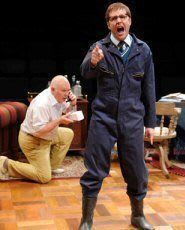It's forty years since Alan Ayckbourn directed one of his most famous comedies. It's also been that long since How the Other Half Loves was presented at a theatre-in-the-round, even though the play was created for such a space. On the evidence of this production, the wait was well worth it.
Other directors have been able to mount clever interpretations of Ayckbourn's work but no one can give a play the unmistakeable Ayckbourn slant.
For instance, he told the cast of How the Other Half Loves that women prefer to discuss their problems with other women. That's because men offer solutions, whereas women listen. That observation allows you to look at the play in a completely different light.
He also explained that none of the characters is particularly complex - interest comes from the situations the characters find themselves in. So the actors don't read anything into the text that Ayckbourn didn't intend.
How the Other Half Loves is formulaic early Ayckbourn, featuring three couples whose lives intertwine as the playwright focuses on the middle classes and their attitude to marriage.
Frank and Fiona Foster are the middle-aged couple who are comfortably off. But Fiona's fling with Bob Phillips whose relationship with wife Teresa is fairly stormy leads to deceit and subterfuge. When Fiona and Bob both cite William and Mary Featherstone as their alibi after they've had a late night together, confusion and misunderstandings lead to humorous outcomes.
Robert Austin and Marilyn Cutts are delightful as the Fosters. He's forgetful, slow on the uptake and slightly loopy yet he gains sympathy because he can't grasp the truth of what's happening around him. She's dismissive in a Sybil Fawlty-esque way yet shows vulnerability when it appears she's been found out. She also does a terrific job of trying to make conversation with the taciturn Featherstones when they're first brought together.
Theo Cross and Rosie Jenkins are enjoyable as the constantly bickering Phillipses. She's the fiery young mum continually weary with looking after their baby almost single-handedly and she's treated abominably by her husband. He's selfish and chauvinistic with a hint of underlying violence as faithfulness is a word he doesn't understand.
On one occasion, though, Bob comes home from the pub the worse for drink only to sober up unbelievably quickly. Perhaps Cross ought to have been told to stay in character slightly longer.
Ian McLarnon and Anna Lowe do a superb job with their portrayals of the difficult roles of the Featherstones. William is a slightly geeky, plain yet bossy husband while Mary is prim, reserved and lacking self-belief. Anna Lowe's strength is her ability to switch instantly from her incoherent manner when she's with the Fosters to being more open in her conversations with Teresa.
Ayckbourn was lauded for the technical skill of How the Other Half Loves which features a clever scene in which two dinner parties held on successive nights take place simultaneously on stage. Here it's superbly done, with the Featherstones on swivel chairs as they face different levels of discomfort with the two other couples.
Ayckbourn directs masterfully, with all the actors showing impeccable timing which extracts the maximum humour from the piece.
There has to be praise too for designer Jan Bee Brown who produces a dexterous set with a sofa and table split in two to differentiate between the two living rooms.
The ending seems a little odd and almost out of keeping with what's gone before. On the whole, though, this is a stellar production. It would be a pity to have to wait another forty years for the next one.
"How the Other Half Loves" runs until September 19th
